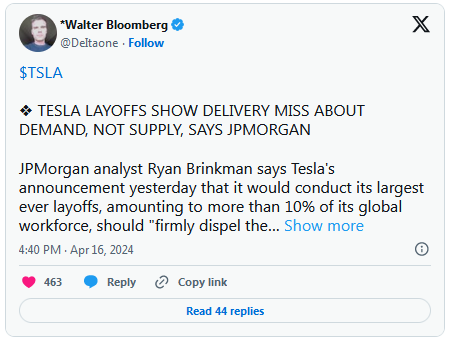Even as Tesla (NASDAQ:TSLA) seemingly faces one setback after another, it’s still the 800-pound elephant in the room when the conversation turns to the electric vehicle (EV) market. Consequently, Tesla’s upcoming first-quarter 2024 earnings report will be a closely watched event for both the bulls and the bears.
So, mark your calendar for Tuesday, April 23, and grab some popcorn, as the earnings report ought to provide thrills, chills or both. While you’re at it, consider whether it might actually make sense to take a pre-earnings Tesla share position, as muted expectations can sometimes lead to positive surprises.
It’s One Problem After Another for Tesla
Speaking of muted expectations, Tesla already released its quarterly EV delivery figure earlier this month. In a shock to investors and analysts, Tesla delivered slightly fewer than 387,000 vehicles in 2024’s first quarter, down approximately 9% year over year. Even Wall Street’s lowest estimate assumed that Tesla would have delivered around 20,000 more vehicles than that.
To view it from another angle, Tesla sold 46,000 fewer vehicles than the company produced during the quarter. This indicates two related issues for Tesla and for the industry as a whole: a vehicle supply glut and persistently soft EV demand.
At this point, there’s no denying that Tesla has serious problems. CEO Elon Musk admitted on his social platform X, “This was a tough quarter for everyone.”
Meanwhile, JPMorgan Chase (NYSE:JPM) analyst Ryan Brinkman stated outright that Tesla’s disappointing first-quarter EV deliveries reflected a “demand problem.”
We’ll revisit Brinkman’s commentary in a moment. It’s worth noting right now, though, that the general tone of Tesla’s upcoming first-quarter earnings report shouldn’t be a complete mystery since the automaker’s vehicle delivery figure is already public knowledge.
Besides, Wall Street isn’t expecting much from the company. The analysts’ consensus estimates call for Tesla to have earned 49 cents per share in 2024’s first quarter, which would represent a considerable drop-off when compared to 71 cents per share in the prior quarter and 85 cents per share in the year-earlier quarter.
It’s also worth mentioning that Tesla had 10 consecutive quarterly EPS beats before breaking that streak with EPS misses in 2023’s third and fourth quarters. Could this possibly be a setup for a not-as-bad-as-expected positive surprise on Tuesday?
That’s worth considering, especially with Tesla facing one problem after another lately. The company announced plans to lay off more than 10% of its staff, in what Wedbush analyst Daniel Ives called an “ominous sign” for Tesla. Furthermore, two veteran Tesla executives are leaving the company.
Then, the market reacted negatively when Musk signaled a commitment to devote more of Tesla’s resources toward self-driving technology in general and robo-taxis in particular. And, in case all of that wasn’t enough, Tesla hit yet another speed bump when the automaker announced a recall of its odd-shaped Cybertruck due to an issue with the vehicle’s accelerator pedal.
The recall only applies to 3,878 Cybertrucks, but the cumulative effect of bad news upon bad news has sent the Tesla share price to fresh short-term lows. Already, TSLA stock has declined around 40% year to date.
Two Pessimistic Tesla Stock Price Targets
Now, let’s circle back to Brinkman, the JPMorgan analyst. He recently lowered his Tesla share-price target from $130 to $115, while assigning a Sell rating to the stock.
Even after the share-price rout, Brinkman warned that TSLA stock “could fall much further still” if Tesla’s vehicle volume and sales growth don’t improve quickly. Along with that, the JPMorgan analyst feels that Tesla’s aforementioned planned layoffs debunk the company’s “hypergrowth narrative.”
$TSLA
— *Walter Bloomberg (@DeItaone) April 16, 2024
❖ TESLA LAYOFFS SHOW DELIVERY MISS ABOUT DEMAND, NOT SUPPLY, SAYS JPMORGAN
JPMorgan analyst Ryan Brinkman says Tesla's announcement yesterday that it would conduct its largest ever layoffs, amounting to more than 10% of its global workforce, should "firmly dispel the…
Brinkman might not be Tesla’s most devoted bear, though. Not long ago, Deutsche Bank (NYSE:DB) analyst Emmanuel Rosner slashed his Tesla stock price target from an already pessimistic $123 to just $89. That would represent a huge drop from today’s Tesla share price of around $150.
Rosner is concerned about Tesla allocating substantial resources toward robo-taxis. That concern is understandable, to a certain extent, since robo-taxis are an early-stage, untested market.
But then, Musk and Tesla didn’t get to where they are today by playing it safe. It’s too soon, I’d say, for investors to declare Musk’s robo-taxi vision a failure, as it really hasn’t even begun in earnest.
That’s a long-term consideration, however. For the immediate future, bold investors may be willing to bet on prevalent pessimism, flipping to widespread post-earnings optimism. All it would take is for Tesla to post quarterly financial results that are at least decent, if not ideal.

